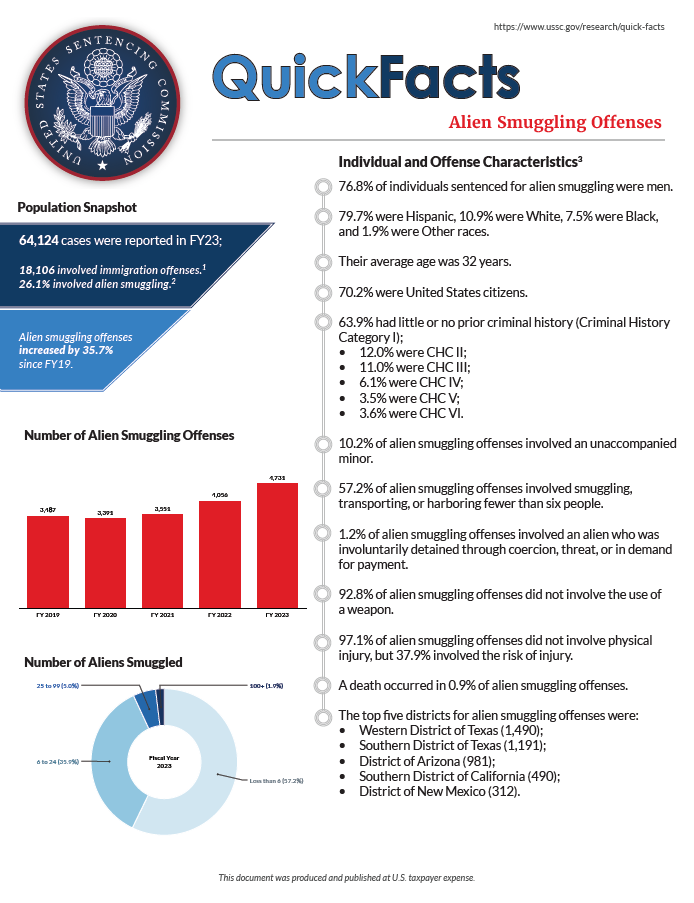Of the 61,678 cases reported to the Commission in fiscal year 2024, 17,336 involved immigration offenses.1 Of those cases, 25.1% involved alien smuggling (up 28.1% since fiscal year 2020).2,3
Click the cover for the PDF handout or learn more below.
Individual and Offense Characteristics
- 78.5% of individuals sentenced for alien smuggling were men.
- 81.2% were Hispanic, 8.6% were Black, 7.7% were White, and 2.5% were Other races.
- Their average age was 33 years.
- 64.6% were United States citizens.
- 71.4% had little or no prior criminal history (Criminal History Category I);
- 11.0% were CHC II;
- 8.4% were CHC III;
- 3.8% were CHC IV;
- 2.8% were CHC V;
- 2.6% were CHC VI.
- 13.2% of alien smuggling offenses involved an unaccompanied minor.
- 59.2% of alien smuggling offenses involved smuggling, transporting, or harboring fewer than six people.
- 0.9% of alien smuggling offenses involved an alien who was involuntarily detained through coercion, threat, or in demand for payment.
- 92.1% of alien smuggling offenses did not involve the use of a weapon.
- 96.2% of alien smuggling offenses did not involve physical injury, but 36.6% involved the risk of injury.
- A death occurred in 1.2% of alien smuggling offenses.
- The top five districts for alien smuggling offenses were:
- Western District of Texas (1,375);
- Southern District of Texas (1,095);
- District of Arizona (773);
- Southern District of California (393);
- District of New Mexico (263).
Punishment
- The average sentence for alien smuggling was 15 months.
- 89.3% of individuals sentenced for alien smuggling were sentenced to prison.
- 1.9% were convicted of an offense carrying a mandatory minimum penalty.
Sentences Relative to the Guideline Range
- 83.8% of sentences for alien smuggling were under the Guidelines Manual.
- 51.8% were within the guideline range.
- 26.6% were Early Disposition Program (EDP) departures.4
- The average sentence reduction was 53.0%.
- The average sentence reduction was 53.0%.
- 2.8% were substantial assistance departures.
- The average sentence reduction was 48.4%.
- The average sentence reduction was 48.4%.
- 2.4% were some other downward departure.
- The average sentence reduction was 46.6%.
- The average sentence reduction was 46.6%.
- 51.8% were within the guideline range.
- 16.2% of sentences for alien smuggling were variances.
- 13.2% were downward variances.
- The average sentence reduction was 48.0%.
- The average sentence reduction was 48.0%.
- 3.0% were upward variances.
- The average sentence increase was 49.4%.
- 13.2% were downward variances.
- The average guideline minimum and average sentence imposed remained steady over the past five years.
- The average guideline minimum was 17 months in fiscal year 2020 and 17 months in fiscal year 2024.
- The average sentence imposed was 13 months in fiscal year 2020 and 15 months in fiscal year 2024.
- The average guideline minimum was 17 months in fiscal year 2020 and 17 months in fiscal year 2024.
1 Immigration cases include cases where individuals were sentenced under USSG §§2L1.1 (Smuggling, Transporting or Harboring an Unlawful Alien), 2L1.2 (Illegal Reentry), 2L2.1 (Trafficking in Documents Relating to Citizenship), 2L2.2 (Fraudulently Acquiring Documents Relating to Citizenship), and 2L2.5 (Failure to Surrender Cancelled Naturalization Certificate).
2 Alien smuggling involves cases in which the court applied USSG §2L1.1 as the primary sentencing guideline.
3 Cases with incomplete sentencing information were excluded from the analysis.
4 “Early Disposition Program" (or EDP) departures are departures where the government sought a sentence below the guideline range because the defendant participated in the government’s Early Disposition Program, through which cases are resolved in an expedited manner. See USSG §5K3.1.
SOURCE: United States Sentencing Commission, FY 2020 through FY 2024 Datafiles, USSCFY20-USSCFY24.

